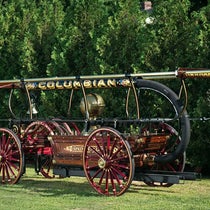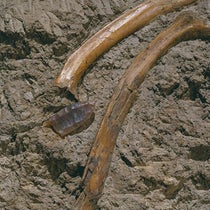Scientist of the Day - Parker Cleaveland
Parker Cleaveland, an American geologist and mineralogist, died on Aug. 15, 1858, at the age of 78. He had been born on Jan. 1, 1780, in Rowley, Mass, in Essex County in the northeast corner of the state. He never got very far from his birthplace, attending Harvard College, teaching math there for a few years, then accepting a position at Bowdoin College, which had been founded in Brunswick in the Commonwealth of Massachusetts in 1794, but which became part of Maine in 1820, thanks to the Missouri Compromise. There is a charming painting of Bowdoin College by John G. Brown, made around 1822 and to be seen in the Bowdoin Museum of Art (first image).
Not finding a textbook suitable for teaching geology, and especially mineralogy, in the U.S., Cleaveland wrote and published his own, An Elementary Treatise on Mineralogy and Geology (1816). It proved to be quite popular in American college science courses and enjoyed a second edition in 1822. We have both editions in our collections, although we show only the first. Charles Darwin took a copy of the first edition with him on the voyage of the Beagle.
There are 6 plates at the back of the first edition of Cleaveland's Elementary Treatise. Five of them show a variety of crystal forms; they are crisp and clean, but no especially noteworthy, except to a mineralogist. The last plate is a geological map of the eastern United States, and it is a stunner, being large, folding, and hand-colored (fourth image). Geological maps of the United States in the early part of the 19th century are very scarce, and this is a good one. I did not know it existed until I opened it up.
Cleaveland divided his rocks into four major divisions, following the scheme of Abraham Gottlob Werner, coding each with a color, which he explained in a commentary on the map. I was struck by the fact that he called the color for alluvial rocks, “gamboge yellow” (fifth image) A man named Patrick Syme had published a book on color nomenclature for geologists, and sure enough, one of his yellows was gamboge yellow (sixth image), and he included vermillion red and rose red, two of Cleaveland’s other map colors, as well. Syme’s book had just been published in 1814 in England; I am amazed that Cleaveland knew about it. Darwin took a copy of Syme’s book with him on the Beagle as well. We have written a post on Syme, where we showed images from our second edition, the edition that Darwin took along.
I looked on the Bowdoin College website for more information on Cleaveland, and stumbled on a webpage that contained student evaluations of the faculty by the class of 1825, the first class to spend all of their college years in the state of Maine. One student wrote of Cleaveland:
…by far, the most distinguished member of the faculty, had but few if any superiors in the country as geologist or chemist. He was a king and genial as he was learned….Never [was a] professor held in higher regard, nor could nay one have inspired more kindly respect
This student was Nathaniel Hawthorne. Another wrote that he found Cleaveland's course “very interesting” (although he didn't understand Chemical Affinity); that student was Henry Wadsworth Longfellow. There was no comment from Hawthorne's best friend, Franklin Pierce, probably because Pierce was in the class of '24. But he took Cleaveland's course, because everybody did.
Cleaveland had a house built in Brunswick in 1808. It was apparently very well crafted, and still stands on the campus today (seventh image). Until recently it was the President's house; apparently it is now used for special occasions and as a V.I.P. guest residence, and is still known as the Cleaveland House.
William B. Ashworth, Jr., Consultant for the History of Science, Linda Hall Library and Associate Professor emeritus, Department of History, University of Missouri-Kansas City. Comments or corrections are welcome; please direct to ashworthw@umkc.edu.













